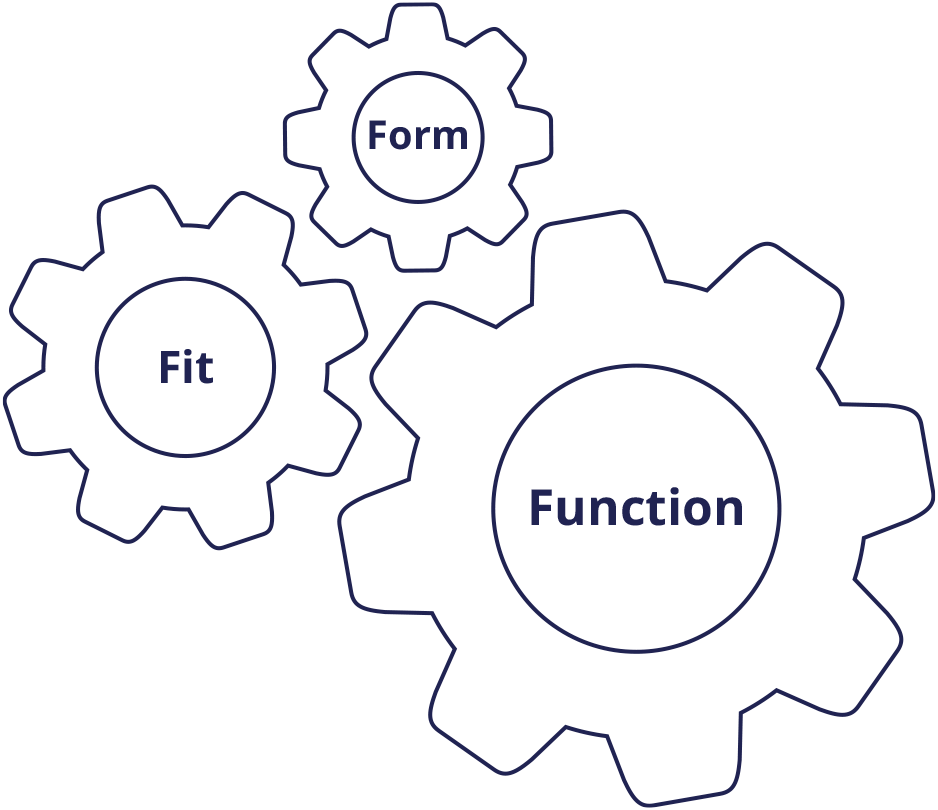Form Fit And Function Definition
Form Fit And Function Definition - This also includes tolerances modifications. Fit is the ability of an item to physically interface with all other components. The ability of an item to physically interface or interconnect with or become an integral part of another item. For software, form denotes the language and media. Form is the physical characteristics of the product. Web form, fit, and function data technical data (td) pertaining to items, components, or processes for the purpose of identifying source, size, configuration, mating and attachment characteristics, functional characteristics, and performance requirements. Fit is short for “fits intended application”. Form refers to such characteristics as external dimensions, weight, size, and visual appearance of a part or assembly. Fit refers to the ability of the part or feature to connect to, mate with, or join to another feature or part within an assembly. The shape, size, dimensions, mass, weight, and other visual parameters which uniquely characterize an item.
For software, form denotes the language and media. Web “form, fit, and function” are most commonly discussed in relation to the design of an object, or when considering if a process is value added or not. Form refers to such characteristics as external dimensions, weight, size, and visual appearance of a part or assembly. Web form, fit, and function data means data relating to items, components, or processes that are sufficient to enable physical and functional interchangeability, and data identifying source, size, configuration, mating and attachment characteristics, functional characteristics, and performance requirements. This also includes tolerances modifications. Web form, fit, and function data means data relating to items, components, or processes that are sufficient to enable physical and functional interchangeability, and data identifying source, size, configuration, mating and attachment characteristics, functional characteristics, and performance requirements. For example, you might describe a screw that will be used in your product as ‘screw, pan head, m3 x 0.5, 2mm lg, 316 ss.’ The shape, size, dimensions, mass, weight, and other visual parameters which uniquely characterize an item. It includes things like shape, weight, color, material, etc. Fit is short for “fits intended application”.
This also includes tolerances modifications. Form is the physical characteristics of the product. The shape, size, dimensions, mass, weight, and other visual parameters which uniquely characterize an item. Web “form, fit, and function” are most commonly discussed in relation to the design of an object, or when considering if a process is value added or not. It includes things like shape, weight, color, material, etc. Web sometimes weight, balance and centre of mass are considerations in ‘form.’. Form refers to such characteristics as external dimensions, weight, size, and visual appearance of a part or assembly. For software, form denotes the language and media. Fit is short for “fits intended application”. Web form, fit, and function data means data relating to items, components, or processes that are sufficient to enable physical and functional interchangeability, and data identifying source, size, configuration, mating and attachment characteristics, functional characteristics, and performance requirements.
Design Reliability and Product Integrity on a Hydraulic Cylinder
Web form, fit, and function data technical data (td) pertaining to items, components, or processes for the purpose of identifying source, size, configuration, mating and attachment characteristics, functional characteristics, and performance requirements. Web form, fit, and function data means data relating to items, components, or processes that are sufficient to enable physical and functional interchangeability, and data identifying source, size,.
Form fits function
The shape, size, dimensions, mass, weight, and other visual parameters which uniquely characterize an item. Function refers to the action or actions. Form is the physical characteristics of the product. The “fit” allows the part to meet the required assembly tolerances to be useful. Fit is the ability of an item to physically interface with all other components.
Building a Work Wardrobe Fit, Form, Function Yours Truly, Katrina
Web form, fit, and function data means data relating to items, components, or processes that are sufficient to enable physical and functional interchangeability, and data identifying source, size, configuration, mating and attachment characteristics, functional characteristics, and performance requirements. Fit refers to the ability of the part or feature to connect to, mate with, or join to another feature or part.
Design for Prototyping Form, Fit, Function and Fabricate Webinar
Web sometimes weight, balance and centre of mass are considerations in ‘form.’. It includes things like shape, weight, color, material, etc. The shape, size, dimensions, mass, weight, and other visual parameters which uniquely characterize an item. Form refers to such characteristics as external dimensions, weight, size, and visual appearance of a part or assembly. This also includes tolerances modifications.
Learning Design Is Form, Fit, Function (FFF) Applicable In The
Web form, fit, and function data means data relating to items, components, or processes that are sufficient to enable physical and functional interchangeability, and data identifying source, size, configuration, mating and attachment characteristics, functional characteristics, and performance requirements. Form refers to such characteristics as external dimensions, weight, size, and visual appearance of a part or assembly. The ability of an.
Beyond PLM (Product Lifecycle Management) Blog FFF (Form, Fit, Function
Web form, fit, and function data means data relating to items, components, or processes that are sufficient to enable physical and functional interchangeability, and data identifying source, size, configuration, mating and attachment characteristics, functional characteristics, and performance requirements. Web “form, fit, and function” are most commonly discussed in relation to the design of an object, or when considering if a.
Form, Fit, and Function (FFF) Definition Arena
For software, form denotes the language and media. Fit refers to the ability of the part or feature to connect to, mate with, or join to another feature or part within an assembly. For example, you might describe a screw that will be used in your product as ‘screw, pan head, m3 x 0.5, 2mm lg, 316 ss.’ The “fit”.
FormFitFunction (FFF) Definition and Rules Arena
Form refers to such characteristics as external dimensions, weight, size, and visual appearance of a part or assembly. Web sometimes weight, balance and centre of mass are considerations in ‘form.’. The ability of an item to physically interface or interconnect with or become an integral part of another item. Function refers to the action or actions. Fit is the ability.
FormFitFunction (FFF) Definition and Rules Arena
Web form, fit, and function data means data relating to items, components, or processes that are sufficient to enable physical and functional interchangeability, and data identifying source, size, configuration, mating and attachment characteristics, functional characteristics, and performance requirements. Fit is the ability of an item to physically interface with all other components. The shape, size, dimensions, mass, weight, and other.
What is Form, Fit, Function & Feasibility Shape Industrial Processes
Form is the physical characteristics of the product. Form refers to such characteristics as external dimensions, weight, size, and visual appearance of a part or assembly. Fit is the ability of an item to physically interface with all other components. It includes things like shape, weight, color, material, etc. For example, you might describe a screw that will be used.
Function Refers To The Action Or Actions.
Fit is the ability of an item to physically interface with all other components. For example, you might describe a screw that will be used in your product as ‘screw, pan head, m3 x 0.5, 2mm lg, 316 ss.’ Web form, fit, and function data technical data (td) pertaining to items, components, or processes for the purpose of identifying source, size, configuration, mating and attachment characteristics, functional characteristics, and performance requirements. The “fit” allows the part to meet the required assembly tolerances to be useful.
Web Form, Fit, And Function Data Means Data Relating To Items, Components, Or Processes That Are Sufficient To Enable Physical And Functional Interchangeability, And Data Identifying Source, Size, Configuration, Mating And Attachment Characteristics, Functional Characteristics, And Performance Requirements.
It includes things like shape, weight, color, material, etc. Form refers to such characteristics as external dimensions, weight, size, and visual appearance of a part or assembly. Form is the physical characteristics of the product. Fit is short for “fits intended application”.
Fit Refers To The Ability Of The Part Or Feature To Connect To, Mate With, Or Join To Another Feature Or Part Within An Assembly.
The ability of an item to physically interface or interconnect with or become an integral part of another item. Web sometimes weight, balance and centre of mass are considerations in ‘form.’. Web “form, fit, and function” are most commonly discussed in relation to the design of an object, or when considering if a process is value added or not. Web form, fit, and function data means data relating to items, components, or processes that are sufficient to enable physical and functional interchangeability, and data identifying source, size, configuration, mating and attachment characteristics, functional characteristics, and performance requirements.
For Software, Form Denotes The Language And Media.
This also includes tolerances modifications. The shape, size, dimensions, mass, weight, and other visual parameters which uniquely characterize an item.









